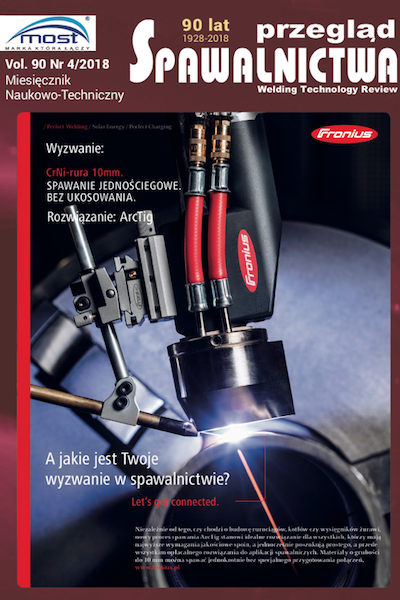A possibility to improve resistance of cast-steel hydraulic valves to cavitation erosion
Main Article Content
Abstract
Inner surfaces of sealing-draining seats in hydraulic valves are usually reproduced by inserts made of a copper alloy joined mechanically with valve housing. As a result of sudden variations in water pressure, they can be subject to loosening which leads to deterioration of valve tightness. In the paper, a new solution is proposed for finishing surfaces of valve seats by application of a plasma-sprayed coating. The solution is validated by results of cavitation erosion resistance test performed for both the CuZn39Pb2Al alloy used earlier for the inserts and the material of coating made of WCCoCr 86104 powder. The resistance assessment was based on geometrical structure of cavitation craters (parameter Rt). It has been found that the plasma-sprayed coating demonstrated a definitely higher resistance to cavitation erosion compared to CuZn39Pb2Al alloy used earlier for valve seat inserts.
in polish
Możliwości poprawy odporności na erozję kawitacyjną staliwnych zaworów hydraulicznych
Powierzchnie wewnętrzne gniazd uszczelniająco-odwadniających zaworów hydraulicznych są zwykle odwzorowane przez wkładki wykonane ze stopu miedzi, które są mechanicznie połączone z korpusem zaworu. Wskutek gwałtownych zmian ciśnienia wody, wkładki te mogą ulec poluzowaniu, co powoduje nieszczelność zaworów. W pracy zaproponowano nowe rozwiązanie poprzez zastosowanie powłoki natryskiwanej plazmowo. Przedstawiono wyniki badań odporności na erozję kawitacyjną dotychczas stosowanego materiału wkładki ze stopu CuZn39Pb2Al oraz materiału powłoki wykonanej z proszku WCCoCr 86104. Oceniono strukturę geometryczną powierzchni kraterów kawitacyjnych (parametr Rt). Stwierdzono, że powłoka naniesiona plazmowo charakteryzuje się zdecydowanie wyższą odpornością na erozję kawitacyjną, w porównaniu do dotychczas stosowanego materiału wkładki ze stopu CuZn39Pb2Al.
Downloads
Article Details
Creative Commons CC BY 4.0 https://creativecommons.org/licenses/by/4.0/
Welding Technology Review (WTR) articles are published open access under a CC BY licence (Creative Commons Attribution 4.0 International licence). The CC BY licence is the most open licence available and considered the industry 'gold standard' for open access; it is also preferred by many funders. This licence allows readers to copy and redistribute the material in any medium or format, and to alter, transform, or build upon the material, including for commercial use, providing the original author is credited.
References
Kumar P., Saini R.P.: Study of cavitation in hydro turbines A review, Renewable and Sustainable Energy Reviews, vol. 14, pp. 374-383, 2010.
Dorji U., Ghomashchi R.: Hydro turbine failure mechanisms: an overview, Eng. Fail. Anal., vol. 44, pp. 136-147, 2014.
Romo S.A., Santa J.F., Giraldo J.E., Toro A.: Cavitation and high-velocity slurry erosion resistance of welded Stellite 6 alloy, Tribology International, vol. 47, pp. 16-24, 2012.
Kwak C.F., Man H.C., Cheng F.T.: Cavitation erosioncorrosion behaviour of laser surface alloyed AISI 1050 mild steel using NiCrSiB, Materials Science and Engineering, A303, pp. 250-261, 2001.
Malek Ghaini F., Ebrahimnia M., Gholizade Sh.: Characteristics of crack in heat affected zone of ductile cast iron in powder welding process, Engineering Failure Analysis, vol. 18, pp. 47-51, 2011.
Ebrahimnia M., Malek Ghaini F., Gholizade Sh., Salari M.: Effect of cooling rate and powder characteristics on the soundness of heat affected zone in powder welding of ductile iron, Materials and Design, vol. 33, pp. 551-556, 2012.
